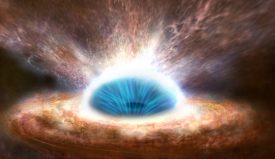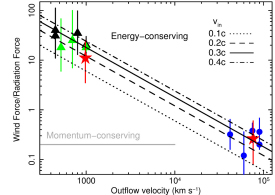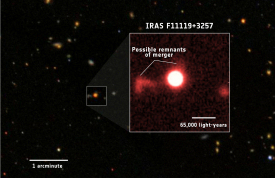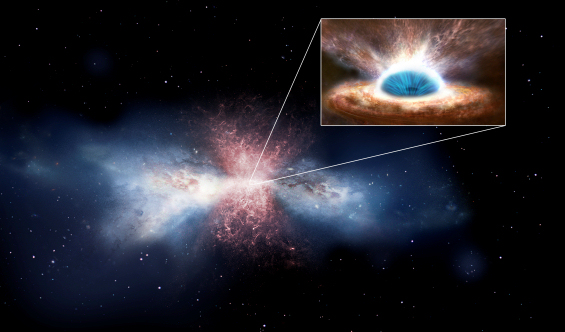How black holes clear galaxies of star-making gas
25 March 2015
Astronomers have found proof that the strong winds blown by a supermassive black hole are dispersing the gas reservoir of its host galaxy. The new finding relies on the observation of two related phenomena in the same galaxy: a large-scale galactic outflow, seen by ESA's Herschel space observatory, and a black-hole driven wind at the galaxy's core, detected with the Japanese/US Suzaku X-ray observatory. By showing how the black hole wind is in fact driving the gas outflow that affects the entire galaxy, the discovery demonstrates the key role played by black holes in regulating the formation of stars in their host galaxies.Galaxies have been forming stars since the Universe was only a few hundred million years old, but over the past 10 billion years this activity has declined. In fact, while the production of stars reached its peak a few billion years after the Big Bang, galaxies in the present Universe are no longer such prolific stellar factories, with a typical galaxy giving birth to just a few new stars every year.
Astronomers have long been wondering about the physical processes that regulate star formation in galaxies: what slowed it down over cosmic history, preventing galaxies from turning all of their gas into stars? Why did some galaxies shut down their production of stars entirely? They suspected that the activity driven by the supermassive black holes at the centre of massive galaxies might be responsible for triggering such a feedback mechanism, but until recently there was no direct proof that this scenario could be acted out on a global galactic scale.
 |
|
Artist's impression of a black hole wind. Credit: ESA/ATG medialab |
"This is the first time that we see a supermassive black hole in action, blowing away the galaxy's reservoir of 'star-making' gas," explains Francesco Tombesi from NASA's Goddard Space Flight Center and the University of Maryland, USA.
Supermassive black holes feed on the surrounding matter but also eject large amounts of material through powerful winds and jets.
"Until now we could only assume that a black hole's activity has a global impact on its host galaxy, but now we can directly prove it," he adds.
Tombesi and his collaborators have found the first evidence that mighty winds driven by supermassive black holes are powering massive outflows in the interstellar matter around them, pushing large amounts of molecular gas away from the centre of their host galaxies. The results are reported in the journal Nature.
This new finding was made possible by combining data from ESA's Herschel, which observed the sky in the far-infrared portion of the electromagnetic spectrum, and from the Japanese/US Suzaku X-ray observatory, which probes some of the most energetic phenomena in the cosmos through their X-ray emission. The multi-wavelength aspect of this study was crucial to linking what happens in the vicinity of the black hole and its global effect on the galaxy as a whole.
The majority of supermassive black holes are idle, but those that are actively accreting matter give rise to intense emission across the electromagnetic spectrum. In particular, X-ray observations are sensitive to what happens very close to the black hole, and have been widely used in the past decade to extract information about the speed and energy of winds driven by the accretion process.
 |
|
Black hole winds from start to finish. Credit: Courtesy of Francesco Tombesi, NASA/Goddard Space Flight Center and University of Maryland, MD, USA |
"In a previous study, we demonstrated that winds are fairly common in galaxies hosting an active black hole: these winds blow away significant amounts of highly ionised gas up to about one third the speed of light," explains Tombesi.
However, while X-ray observations can investigate the outflow of ionised gas in the central regions of a galaxy, they provide only a crude indication of what is going on at a galactic level. It is at the longer (far-infrared) wavelengths probed by Herschel that astronomers can keep an eye on larger-scale outflows by looking at the molecular gas – the raw material needed for stars to form.
"With Herschel, we could finally see directly that also the molecular gas is being swept away from galaxies," says co-author Eduardo González-Alfonso from Universidad de Alcalá, in Spain.
In previous studies, large-scale outflows of molecular gas were detected in a number of Ultra-Luminous InfraRed Galaxies (ULIRGs) scrutinised with Herschel. ULIRGs are systems undergoing a galactic merger between two gas-rich progenitors, on the way to becoming an elliptical galaxy.
While these Herschel data provided solid evidence that galactic winds are blowing away the gas necessary to form stars, it was not possible to pin down what was powering these winds. Something was still missing: one single galaxy where winds are observed both in the ionised gas around the black hole and in the molecular gas on a broader scale.
"This was an observational challenge, since galaxies that shine brightly at far-infrared wavelengths are not necessarily strong sources of X-rays," explains Marcio Meléndez, a co-author of the paper from the University of Maryland.
 |
| Ground-based image of galaxy IRAS F11119+3257. Credit: NASA's Goddard Space Flight Center/SDSS/S. Veilleux |
Eventually, the astronomers found the right candidate: IRAS F11119+3257, a ULIRG at redshift 0.189, whose light has taken some two billion years to reach us. This galaxy, which had already been observed with Herschel, revealing the presence of large-scale outflows of molecular gas, is also a bright X-ray source, so it seemed to be the best for this study. In May 2013, the astronomers observed it with the X-ray telescope on the Suzaku satellite to look for a signature of its black hole activity.
"And it was a good choice, since the X-ray data revealed that the black hole at the centre of this galaxy is producing one of the most powerful accretion-driven winds ever detected," comments Tombesi.
With both Herschel and Suzaku data at hand, the astronomers could finally test the feedback models quantitatively. The new observations showed that about twenty percent of the fast, black-hole driven wind impacts molecular gas in the diffuse interstellar medium that pervades the galaxy, initiating a slower but more widespread wind on galactic scales.
"While the initial wind only blows away about the equivalent of one solar mass of ionised gas every year, the outflow of molecular gas is much more substantial, affecting at least the equivalent of a few hundred solar masses per year," says Meléndez.
While the black-hole driven wind in this galaxy blows at about 25 percent the speed of light, the outflow of molecular gas is more extended but significantly slower, progressing at about 1000 km/s.
"These values are consistent with the black hole starting a feedback mechanism that can eventually sweep away most of the host galaxy's molecular gas reservoir, possibly bringing an end to its star-forming activity," adds co-author Sylvain Veilleux, also from the University of Maryland.
Moreover, the comparison between the X-ray and far-infrared data suggests that energy is conserved, not dissipated, in the interaction between the accretion-driven wind and the surrounding interstellar medium. This causes an energy boost and powers the vast outflow of molecular gas, in agreement with the predictions from black-hole feedback models.
"Herschel has been a game-changer for studying how stars formed in galaxies throughout the history of the Universe," comments Göran Pilbratt, Herschel Project Scientist at ESA.
"This joint effort between Herschel and Suzaku has now demonstrated how a central black hole can power large-scale molecular gas outflows quenching the formation of stars".
More information
"Wind from the black-hole accretion disk driving a molecular outflow in an active galaxy" by F. Tombesi, M. Meléndez, S. Veilleux, J. N. Reeves, E. González-Alfonso, and C. S. Reynolds, is published in the 26 March 2015 issue of the journal Nature.
The study is based on observations performed at far-infrared wavelengths with the PACS instrument on ESA's Herschel space observatory and in X-rays with the Suzaku X-ray Observatory. Suzaku is a mission of the Institute of Space and Astronautical Science (ISAS)/Japan Aerospace Exploration Agency (JAXA) developed in collaboration with institutes in Japan and the U.S.A., including NASA/GSFC and MIT.
Herschel is an ESA space observatory with science instruments provided by European-led Principal Investigator consortia and with important participation from NASA.
The PACS instrument contains an imaging photometer (camera) and an imaging spectrometer. The camera operates in three bands centred on 70, 100, and 160 μm, respectively, and the spectrometer covers the wavelength range between 51 and 220 μm. PACS has been developed by a consortium of institutes led by MPE (Germany) and including UVIE (Austria); KU Leuven, CSL, IMEC (Belgium); CEA, LAM (France); MPIA (Germany); INAF-IFSI/OAA/OAP/OAT, LENS, SISSA (Italy); IAC (Spain). This development has been supported by the funding agencies BMVIT (Austria), ESA-PRODEX (Belgium), CEA/CNES (France), DLR (Germany), ASI/INAF (Italy), and CICYT/MCYT (Spain).
Herschel was launched on 14 May 2009 and completed science observations on 29 April 2013.
Contacts
Francesco Tombesi
X-ray Astrophysics Laboratory
NASA/Goddard Space Flight Center
Greenbelt, MD, USA
and Department of Astronomy and CRESST
University of Maryland, MD, USA
Email: ftombesi![]() astro.umd.edu
astro.umd.edu
Phone: +1-301-405-3615 / +1-301-286-2661
Marcio Meléndez
Department of Astronomy
University of Maryland, MD, USA
Email: marcio![]() astro.umd.edu
astro.umd.edu
Phone: +1-301-405-0363
Eduardo González-Alfonso
Universidad de Alcalá
Alcalá de Henares, Madrid, Spain
Email: eduardo.gonzalez![]() uah.es
uah.es
Phone: +34-91-885-6767
Sylvain Veilleux
Department of Astronomy
University of Maryland, MD, U.S.A.
Email: veilleux![]() astro.umd.edu
astro.umd.edu
Phone: +1-301-405-0282
Göran Pilbratt
Herschel Project Scientist
Scientific Support Office
Science and Robotic Exploration Directorate
ESA, The Netherlands
Email: gpilbratt![]() cosmos.esa.int
cosmos.esa.int
Phone: +31-71-565-3621







